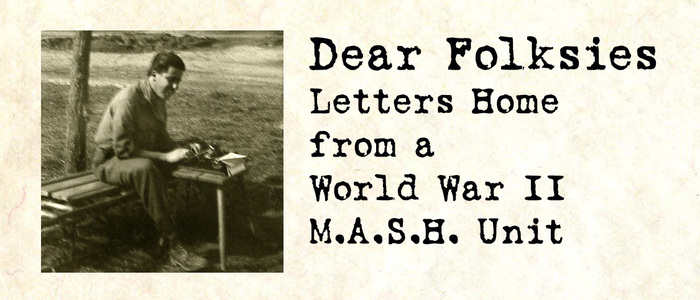July 12, 1944
 July 12, 1944 is Rene’s 29th birthday, but since we don’t have a letter from him, here’s an excerpt from the journal of Dr. Philip Westdahl about the unit’s departure from Anzio.
July 12, 1944 is Rene’s 29th birthday, but since we don’t have a letter from him, here’s an excerpt from the journal of Dr. Philip Westdahl about the unit’s departure from Anzio.
By July 12, the day of our departure from Anzio, the old beach head had become a desolate spot, far out of the way of the war. Only the innumerable foxholes and occasional abandoned and wrecked guns and planes remained as landmarks to tell the story of what was once the site of very bitter fighting.
As usual, when units leave an area, all sorts of old, but usable, equipment was left behind, such as helmets, cans of oil, innumerable gasoline cans, torn, but repairable tents, lumber in abundance. All of these things are small in themselves, but when multiplied by the thousands, their cost – to be borne by taxation for decades to come – becomes a mighty personal problem.
Our route took us through Littoria into a now famous Highway 7 (the Appian Way) through Itri and Terrancinia and Formia, still masses of rubble, but slowly witnessing the return of their inhabitants. We passed through the Pontine marsh area, and noted that the acres and acres of farmland flooded when the retreating Nazis opened the flood gates were gradually showing their soil above water. Watermarks midway up on the walls of farmhouses served as markers of the ruthless desperation of the enemy.
Wherever the water had receded, even though it be only a few square yards of soil, the civilian occupants had started its cultivation. Where bridges once crossed the large drainage canals, industrious old men now ferried the traffic across on crude, flat-bottomed boats – carefully avoiding collision with the partially submerged concrete and steel of the former bridge.
On all major highways the efficient work of our own Army engineers had restored all railroad and highway bridges to accommodate even the heaviest loads. Such familiar landmarks as the Mussolini Canal and Volturno River, scenes of well-known battles, were the sites of our most impressive bridge construction.
.


